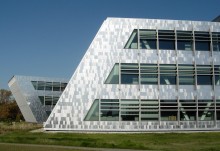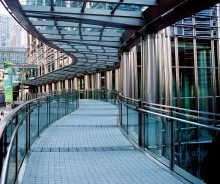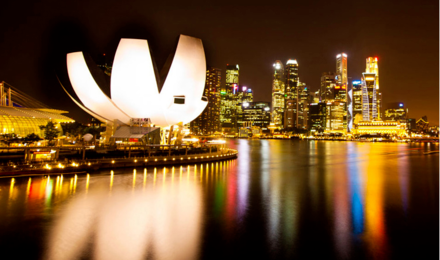Stainless steel in Architecture, Building & Construction
Stainless steel in Architecture, Building & Construction
Stainless steel is used in all aspects of architecture, building and construction. It is not a new material that it has been used in these industries since the 1920's and is applied in more and more applications.
Some applications are highly visible and stainless steel is both aesthetic and functional, such as curtain wall and roofing. Others are practical, safety related and sometimes hidden, like masonry and stone anchors, bollards and safety railings.
The number of different stainless steel alloys used in building and construction has expanded. The more highly alloyed molybdenum containing stainless steels are preferred by leading architectural and landscape design and structural engineering firms for more corrosive locations because of their enhanced corrosion resistance.




Stainless steel is applied in Art and Science Museum in Singapore
Art and Science Museum is one of the most eye-catching buildings in Singapore. The shape of the building is like a huge lotus, and its external stainless steel composite materials have properties of both durability and aesthetics.
Located in the commercial center of Singapore, Marina Bay Sands is a commercial, recreational and entertainment resort in Asia. The shape of the building is designed as a blooming lotus like landmark building - Art and Science Museum is located on the Singapore River, next to the seaside Bay Sands Resort.
The material used for the exterior panel of the museum is ALPOLICTM/frSCM provided by Mitsubishi Plastics. The total thickness of the stainless steel composite (SCM) panel is 4mm, which is composed of the fireproof material in the core and the stainless steel cladding with the thickness of 0.3mm on both sides. The surface of the panel was shot blasting to obtain good surface effect.
The material used for the exterior panel of the museum is ALPOLICTM/frSCM provided by Mitsubishi Plastics. The total thickness of the stainless steel composite (SCM) panel is 4mm, which is composed of the fireproof material in the core and the stainless steel cladding with the thickness of 0.3mm on both sides. The surface of the panel was shot blasting to obtain good surface effect.

Advantages of using stainless steel
The outer surface material of the panel is SUS316, while the back material is 304. Compared with all stainless steel, these stainless steel composite materials greatly reduce the weight and achieve high-grade design and excellent corrosion resistance. A total of 17,000kg of stainless steel was used for the outer cladding of the museum.
The beautiful appearance and excellent characteristics of the museum fully demonstrate the advantages of stainless steel. The combination of plastic and stainless steel can overcome the defects of weight and panel treatment. Mitsubishi develops stainless steel composite materials in order to expand the application scope of its products and occupy part of the market in construction engineering and other fields.
Because the museum is located in a prosperous city close to the sea, it needs to be cleaned regularly to remove harmful substances such as metal particles in the atmosphere and salt deposit dirt.
How to select proper stainless materials in construction
Air pollution, salt exposure, weather patterns, design and cleaning frequency must be considered when selecting stainless steel and other construction materials if good long term performance is desired. IMOA has created a library of resources on this website to provide industry professionals with the information needed to make good stainless steel selection decisions.
In applications with coastal or deicing salt, industrial pollution, volcanic or other corrosive environment exposure, a molybdenum-containing stainless steel with a smooth surface finish is needed unless frequent cleaning is acceptable. Molybdenum improves pitting and crevice corrosion resistance, which is particularly helpful in preventing staining due to salt and corrosive pollution damage.




